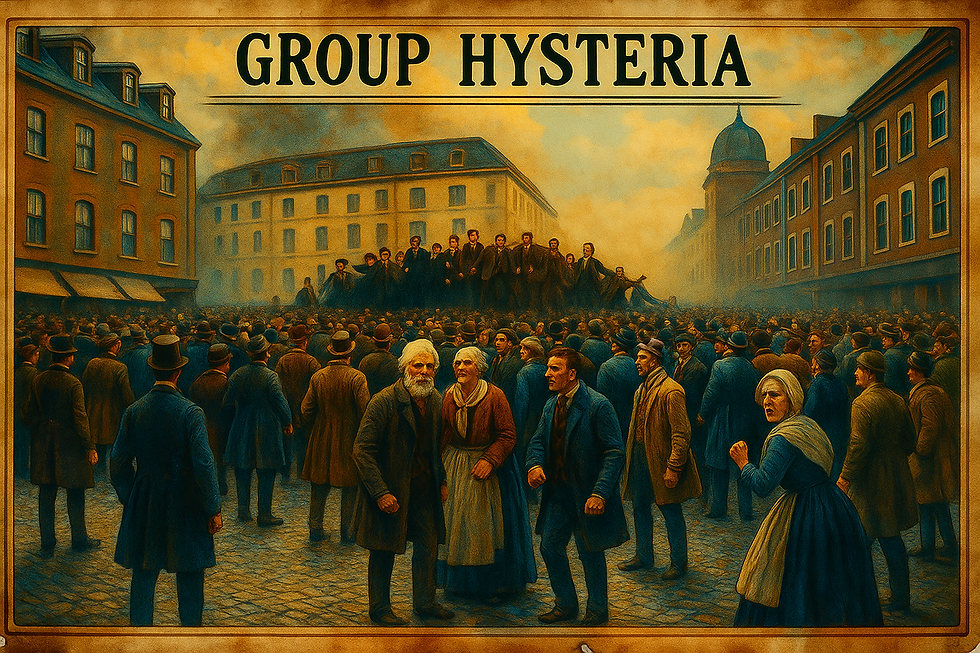The Forgotten Witch Trials of South Carolina
- Bee Williams

- Jun 16
- 4 min read

When we think of witch trials in America, the infamous Salem witch trials of 1692 often come to mind. However, lesser-known episodes of witch hysteria also unfolded in other corners of the early United States, including the rural heart of South Carolina. In 1792, a small community about 30 miles north of Columbia, known today as Winnsboro, became the unlikely setting for a chilling chapter in America’s history of fear and superstition. This blog revisits The Forgotten Witch Trials of South Carolina.

The Rising Panic
The panic began innocently enough with a series of strange occurrences. Cattle in the area started to fall mysteriously ill. Some townspeople reported bizarre encounters, including people levitating and even shapeshifting into animals. Others claimed to suffer from unexplained illnesses. As whispers of witchcraft spread, the fear took hold, and the small community found itself gripped by paranoia.
The turning point came according to an article published in the South Carolina Gazette on November 10, 1792. It described a violent attack on three elderly individuals accused of witchcraft. According to the article, “A number of wretches have beaten and abused a man about 80 years old and two women, who both exceed that age, because they happened to possess more sense than their neighbors and were otherwise strikingly distinguished from them by their inoffensive conduct and purity of their morals.”
The report continued: “These remarkable singularities gave rise to a pretended belief that they were agents of the devil, that they were guilty of the sin of witchcraft, and they were treated accordingly. After whipping them in a most shocking manner, hot coals were applied to their extremities ’till signs of life were scarcely discernible.”

The Accused
While the exact number of accused witches is debated, three names have emerged as central figures in this tragic episode: Mary Ingleman, Hending Smith, and Sally Smith. These people, all advanced in age, were accused not just of consorting with the devil but of bizarre supernatural feats.
Mary Ingleman, a German immigrant in her seventies, bore the brunt of the accusations. Her alleged crimes included levitating a cow into the air before dropping it to its death, an image that eerily echoes modern-day accounts of cattle mutilations by unidentified flying objects. Additionally, a local woman claimed that Ingleman caused her to levitate and spit up balls of hair embedded with pins — a gruesome image that would have stoked the fears of any superstitious neighbor.
In a 1969 article recounting the case, two sisters named Henley reportedly testified that Ingleman had caused them to have fits so violent that they would rise from their beds and cling to the ceiling. It was said that even four strong men could not hold them down. Such accounts echo stories of poltergeist activity or even modern narratives of alien abductions.
Adding to the surreal nature of the accusations, Isaac Collins claimed that Ingleman transformed him into a horse and rode him to a “grand convention of witches,” where the devil himself reportedly complimented Ingleman on her mount, to which she supposedly replied, “Ah, this is that rascal Collins!”

The Trial and Aftermath
The community’s paranoia reached its peak when a makeshift trial was held. According to an 1837 letter from attorney Philip Edward Pearson, published in the Keowee Courier in 1859, the trial took place at the house of a local man, Thomas Hill. Four individuals were “tried” before a self-appointed panel, found guilty, and punished in a brutal fashion. They were flogged and their feet burned at a bark fire until the soles came off, a horrifying method intended to force confessions or drive out the supposed evil spirits.
Remarkably, despite their horrific injuries, the accused women survived. Mary Ingleman, showing extraordinary resilience, pursued justice in the aftermath, bringing her chief tormentor, John Crossland, to court. Crossland was found guilty of aggravated assault and fined five pounds, though he never paid the fine and ultimately fled the county. Another of her attackers, Joshua Durham, was acquitted, further illustrating the uneven and deeply flawed nature of justice in that era. The court records documenting these trials are preserved in the Fairfield County Courthouse and indexed by historian Brent Holcombe.

The Real Cause of the Hysteria
Theories have emerged over the centuries to explain this fevered burst of witch hysteria. Some have speculated that ergot poisoning, a fungal infection of rye grain that can produce LSD-like hallucinations, might have been to blame. However, this seems an overly simplistic answer. More likely, the real cause lies in the darker corners of human nature — fear of the outsider, a desire for control, and the need to scapegoat those who stand apart from the norm. These forces have repeatedly driven communities to act with cruelty toward their most vulnerable members.

A Cautionary Tale
The South Carolina witch trials remain a cautionary tale, a stark reminder of the dangers of mass hysteria and the human tendency to seek convenient but misguided explanations for the unknown. As history has shown time and again, the true monsters are often not those on trial, but the fearful mobs and unchecked zeal that condemn them.
Today, this largely forgotten chapter serves as a reminder to question our assumptions and to be wary of letting fear and superstition override compassion and reason.




Comments